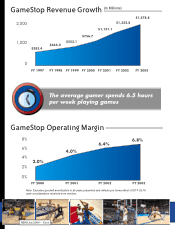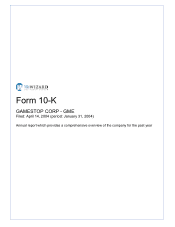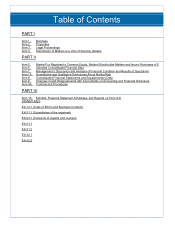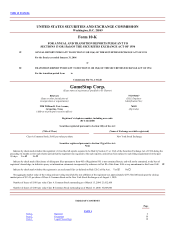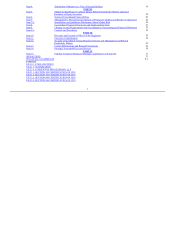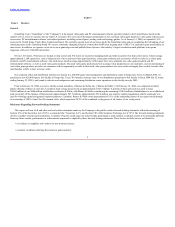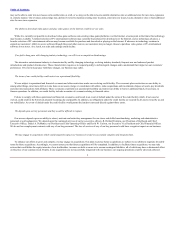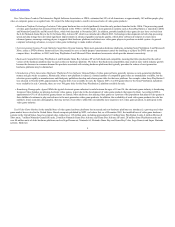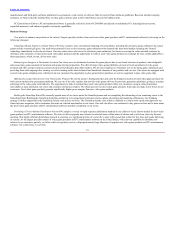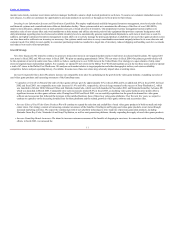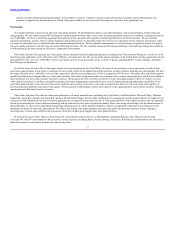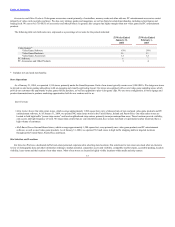GameStop 2003 Annual Report Download - page 16
Download and view the complete annual report
Please find page 16 of the 2003 GameStop annual report below. You can navigate through the pages in the report by either clicking on the pages listed below, or by using the keyword search tool below to find specific information within the annual report.
Table of Contents
Legislative actions, higher director and officer insurance costs and potential new accounting pronouncements are likely to cause our general and administrative
expenses to increase and impact our future financial condition and results of operations.
In order to comply with the Sarbanes-Oxley Act of 2002, as well as changes to the New York Stock Exchange listing standards and rules adopted by the Securities
and Exchange Commission (the “SEC”), we may be required to increase our internal controls, hire additional personnel and additional outside legal, accounting and
advisory services, all of which may cause our general and administrative costs to increase. Insurers are also likely to increase premiums as a result of the high claims
rates they have incurred over the past year from other companies, and so our premiums for our directors’ and officers’ insurance policies are likely to increase. Changes
in the accounting rules, including legislative and other proposals to account for employee stock options as a compensation expense among others, could materially
increase the expenses that we report under generally accepted accounting principles and adversely affect our operating results.
Risks Related to our Relationship with Barnes & Noble
Barnes & Noble’s control of our company could increase the difficulty of our acquisition by another company, even if such acquisition would be beneficial.
Barnes & Noble owns 100% of our outstanding Class B common stock, which represents 94.5% of the combined voting power of all classes of our voting stock. In
addition, some of the members of our board of directors also serve as directors of Barnes & Noble. As a result, Barnes & Noble has control over us, the election of our
board of directors and our management and policies. Barnes & Noble also has control over all matters requiring stockholder approval, including the amendment of
certain provisions of our Amended and Restated Certificate of Incorporation and Bylaws and the approval of fundamental corporate transactions, including mergers. In
light of this control, other companies could be discouraged from initiating a potential merger, takeover or any other transaction resulting in a change of control. Such a
transaction potentially could be beneficial to our business or to our stockholders. This may in turn reduce the price that investors are willing to pay in the future for
shares of our Class A common stock.
If Barnes & Noble distributes our shares of Class B common stock in a tax-free distribution, the Class A common stock may trade at a lower price than the Class
B
common stock.
If Barnes & Noble distributes our Class B common stock to its stockholders in a tax-free distribution, we will have two separate classes of publicly traded common
stock. Following a tax-free distribution of the Class B common stock, the Class B common stockholders will continue to exercise voting control over us. Barnes &
Noble may qualify for a tax-free distribution of our Class B common stock as early as October 2004. This could result in less liquidity for either class of our common
stock than if there were only one class of common stock and could result in the market price of our Class A common stock being lower than the market price of our
Class B common stock.
Any conflict of interest between us and Barnes & Noble could hurt our business or prospects.
There is a possibility that conflicts of interest will arise between Barnes & Noble and us in various areas pertaining to our past and ongoing relationships. Potential
factors that may create a conflict of interest between Barnes & Noble and us are:
• some of the members of our board of directors also sit on Barnes & Noble’s board of directors, which could result in Barnes & Noble’s interests being prioritized
over our interests; and
• some of the members of our board of directors currently have, or may have in the future, an equity interest in Barnes & Noble, which could affect their decisions
in resolving potential conflicts between us and Barnes & Noble.
In addition, Leonard Riggio, one of our directors, is the Chairman of the Board and a principal stockholder of Barnes & Noble. As of March 1, 2004, Mr. Riggio
beneficially owned approximately 20.3% of the outstanding common stock of Barnes & Noble. Mr. Riggio also currently has options to acquire
7


